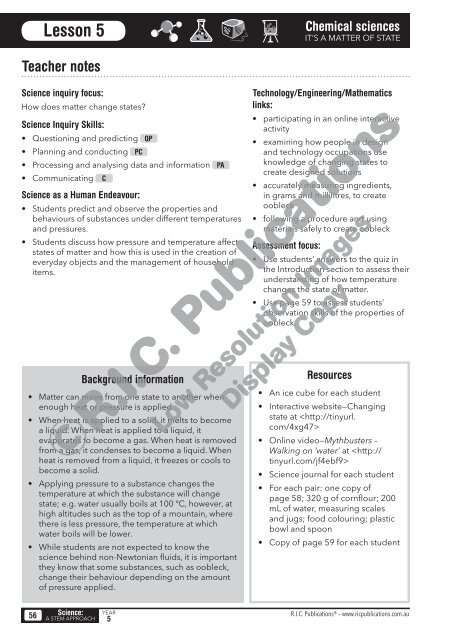20389_Science_with_STEM_Year_5_Chemical_Sciences_Its_a_matter_of_state
You also want an ePaper? Increase the reach of your titles
YUMPU automatically turns print PDFs into web optimized ePapers that Google loves.
Lesson 5<br />
<strong>Chemical</strong> sciences<br />
IT’S A MATTER OF STATE<br />
Teacher notes<br />
<strong>Science</strong> inquiry focus:<br />
How does <strong>matter</strong> change <strong>state</strong>s?<br />
<strong>Science</strong> Inquiry Skills:<br />
• Questioning and predicting QP<br />
• Planning and conducting PC<br />
• Processing and analysing data and information PA<br />
• Communicating<br />
<strong>Science</strong> as a Human Endeavour:<br />
C<br />
• Students predict and observe the properties and<br />
behaviours <strong>of</strong> substances under different temperatures<br />
and pressures.<br />
• Students discuss how pressure and temperature affect<br />
<strong>state</strong>s <strong>of</strong> <strong>matter</strong> and how this is used in the creation <strong>of</strong><br />
everyday objects and the management <strong>of</strong> household<br />
items.<br />
Background information<br />
• Matter can move from one <strong>state</strong> to another when<br />
enough heat or pressure is applied.<br />
• When heat is applied to a solid, it melts to become<br />
a liquid. When heat is applied to a liquid, it<br />
evaporates to become a gas. When heat is removed<br />
from a gas, it condenses to become a liquid. When<br />
heat is removed from a liquid, it freezes or cools to<br />
become a solid.<br />
• Applying pressure to a substance changes the<br />
temperature at which the substance will change<br />
<strong>state</strong>; e.g. water usually boils at 100 ºC, however, at<br />
high altitudes such as the top <strong>of</strong> a mountain, where<br />
there is less pressure, the temperature at which<br />
water boils will be lower.<br />
• While students are not expected to know the<br />
science behind non-Newtonian fluids, it is important<br />
they know that some substances, such as oobleck,<br />
change their behaviour depending on the amount<br />
<strong>of</strong> pressure applied.<br />
Technology/Engineering/Mathematics<br />
links:<br />
• participating in an online interactive<br />
activity<br />
• examining how people in design<br />
and technology occupations use<br />
knowledge <strong>of</strong> changing <strong>state</strong>s to<br />
create designed solutions<br />
• accurately measuring ingredients,<br />
in grams and millilitres, to create<br />
oobleck<br />
• following a procedure and using<br />
materials safely to create oobleck<br />
Assessment focus:<br />
• Use students’ answers to the quiz in<br />
the Introduction section to assess their<br />
understanding <strong>of</strong> how temperature<br />
changes the <strong>state</strong> <strong>of</strong> <strong>matter</strong>.<br />
• Use page 59 to assess students’<br />
observation skills <strong>of</strong> the properties <strong>of</strong><br />
oobleck.<br />
Resources<br />
• An ice cube for each student<br />
• Interactive website—Changing<br />
<strong>state</strong> at <br />
• Online video—Mythbusters –<br />
Walking on ‘water’ at <br />
• <strong>Science</strong> journal for each student<br />
• For each pair: one copy <strong>of</strong><br />
page 58; 320 g <strong>of</strong> cornflour; 200<br />
mL <strong>of</strong> water, measuring scales<br />
and jugs; food colouring; plastic<br />
bowl and spoon<br />
• Copy <strong>of</strong> page 59 for each student<br />
©R.I.C. Publications<br />
Low Resolution Images<br />
Display Copy<br />
56 <strong>Science</strong>:<br />
A <strong>STEM</strong> APPROACH<br />
YEAR<br />
5<br />
R.I.C. Publications® – www.ricpublications.com.au


















